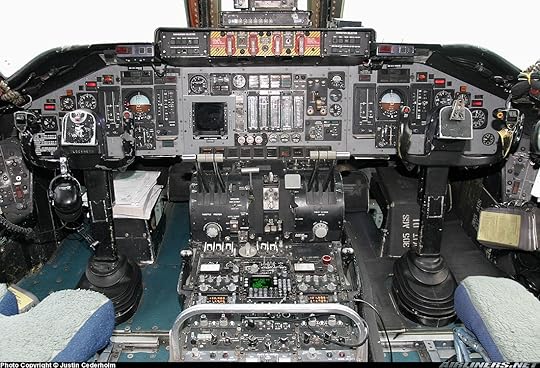Trent Ruble's Blog: The Other Way It Is - Posts Tagged "flying-lesson"
Ladies and Gentlemen, this is NOT Your Captain Speaking...
Wouldn't it be scary to discover the person piloting your airplane had never done it before, had no training and had no idea what he was doing? That's exactly what happened one night in the early 1980s in a US Air Force C-141 Starlifter over the Mediterranean Sea.
Our crew was flying across the sea from Cairo to Athens with a load of cargo and just a few passengers. Like me, our plane was about 20 years old. I was the loadmaster. I was responsible for the on and off-loading, figuring the center of gravity and supervising passengers. So, unless we had passengers, my job was usually over once the plane took off. On this particular flight, it was late at night and the few passengers on board were sleeping. This meant some down time for me.
I climbed into the cockpit and sat in the jump seat. This was a small seat between and just behind the pilots' seats. I liked to do this because I felt more a part of the crew when I wasn't isolated in the back. Plus, I could see out the windows much better, although being over the sea at this time of night meant seeing only blackness.
After some time the flight engineer, who sat directly behind the co-pilot, got up to stretch his legs or use the bathroom. In his absence, the pilot, who also served as the aircraft commander, sat down at the engineer's panel. This was a panel full of gauges monitoring systems such hydraulics, pressurization, fuel, etc... It is my understanding that the aircraft commander must be qualified at this and every position on the plane, so we were not in any danger as he began adjusting things.

I said, "If the pilot can be the engineer, I think the loadmaster should be the pilot!" Of course I was kidding as I had no idea how to fly that airplane, nor did I want to. But the pilot, whose name I would not reveal even if I did remember it, said, "Sit down, Buddy," while pointing to the pilot's seat. I then started backpedaling saying, "I was just kidding. I wouldn't even know what to do." "Don't worry," he said, "I'll help you."
So, I sat down in the pilot's seat. In front of me was the yoke that looks somewhat like half a steering wheel and beside me to the right were the four throttle control levers, one for each of the jet engines. Behind the yoke was an array of gauges, one of which was a brown and white ball with an image of the airplane superimposed on it to indicate our position in relation to the horizon. All of these were intimidating to me.
After a few moments I realized I was doing pretty well as the plane was cruising along just as it had been. The pilot then disconnected the auto-pilot but, even then, the aircraft remained stable. I said, "This is easier than I thought." He said, "Why don't you turn your wheel just a little?" I did as he said and suddenly the airplane not only turned in that direction, but stated to fall from the sky! He said, "Now, increase the power." I pushed the throttles forward and the plane started to climb. He then instructed me to turn the airplane back to the direction we'd been going but, as I did this, it began to fall again. The brown and white ball was now in full wobble. I increased power again which caused me, and likely everyone else on board, to feel as if we were going to throw up. It was like an out-of-control roller coaster seven miles above the Earth! All the while, the pilot was calmly speaking to the Egyptian air-traffic controllers as if everything was normal. I wondered how a pilot could possibly keep all this under control while at the same time trying to decipher their poor English.
I told the pilot that I'd had enough of this adventure and asked if he would take over. After switching positions, I told him that I very much appreciated the experience but I didn't need to do that again. I returned to the cargo compartment where I felt much more comfortable. I found the previously sleeping passengers now awake and wondering if we'd had to avoid an especially bad storm. I explained that there had been a new pilot gaining some experience under the close supervision of the aircraft commander and they were never in danger. I wondered if that were true.
Our crew was flying across the sea from Cairo to Athens with a load of cargo and just a few passengers. Like me, our plane was about 20 years old. I was the loadmaster. I was responsible for the on and off-loading, figuring the center of gravity and supervising passengers. So, unless we had passengers, my job was usually over once the plane took off. On this particular flight, it was late at night and the few passengers on board were sleeping. This meant some down time for me.
I climbed into the cockpit and sat in the jump seat. This was a small seat between and just behind the pilots' seats. I liked to do this because I felt more a part of the crew when I wasn't isolated in the back. Plus, I could see out the windows much better, although being over the sea at this time of night meant seeing only blackness.
After some time the flight engineer, who sat directly behind the co-pilot, got up to stretch his legs or use the bathroom. In his absence, the pilot, who also served as the aircraft commander, sat down at the engineer's panel. This was a panel full of gauges monitoring systems such hydraulics, pressurization, fuel, etc... It is my understanding that the aircraft commander must be qualified at this and every position on the plane, so we were not in any danger as he began adjusting things.

I said, "If the pilot can be the engineer, I think the loadmaster should be the pilot!" Of course I was kidding as I had no idea how to fly that airplane, nor did I want to. But the pilot, whose name I would not reveal even if I did remember it, said, "Sit down, Buddy," while pointing to the pilot's seat. I then started backpedaling saying, "I was just kidding. I wouldn't even know what to do." "Don't worry," he said, "I'll help you."
So, I sat down in the pilot's seat. In front of me was the yoke that looks somewhat like half a steering wheel and beside me to the right were the four throttle control levers, one for each of the jet engines. Behind the yoke was an array of gauges, one of which was a brown and white ball with an image of the airplane superimposed on it to indicate our position in relation to the horizon. All of these were intimidating to me.
After a few moments I realized I was doing pretty well as the plane was cruising along just as it had been. The pilot then disconnected the auto-pilot but, even then, the aircraft remained stable. I said, "This is easier than I thought." He said, "Why don't you turn your wheel just a little?" I did as he said and suddenly the airplane not only turned in that direction, but stated to fall from the sky! He said, "Now, increase the power." I pushed the throttles forward and the plane started to climb. He then instructed me to turn the airplane back to the direction we'd been going but, as I did this, it began to fall again. The brown and white ball was now in full wobble. I increased power again which caused me, and likely everyone else on board, to feel as if we were going to throw up. It was like an out-of-control roller coaster seven miles above the Earth! All the while, the pilot was calmly speaking to the Egyptian air-traffic controllers as if everything was normal. I wondered how a pilot could possibly keep all this under control while at the same time trying to decipher their poor English.
I told the pilot that I'd had enough of this adventure and asked if he would take over. After switching positions, I told him that I very much appreciated the experience but I didn't need to do that again. I returned to the cargo compartment where I felt much more comfortable. I found the previously sleeping passengers now awake and wondering if we'd had to avoid an especially bad storm. I explained that there had been a new pilot gaining some experience under the close supervision of the aircraft commander and they were never in danger. I wondered if that were true.
Published on February 02, 2018 13:33
•
Tags:
air-force, aircraft, airplane, c-141, cargo-plane, flight, fly, flying, flying-lesson, loadmaster, pilot, starlifter, us-air-force, usaf
The Other Way It Is
The stories and opinions of author Trent Ruble.
Find Trent Ruble on Facebook at: https://www.facebook.com/taruble/ The stories and opinions of author Trent Ruble.
Find Trent Ruble on Facebook at: https://www.facebook.com/taruble/ ...more
Find Trent Ruble on Facebook at: https://www.facebook.com/taruble/ The stories and opinions of author Trent Ruble.
Find Trent Ruble on Facebook at: https://www.facebook.com/taruble/ ...more
- Trent Ruble's profile
- 17 followers



